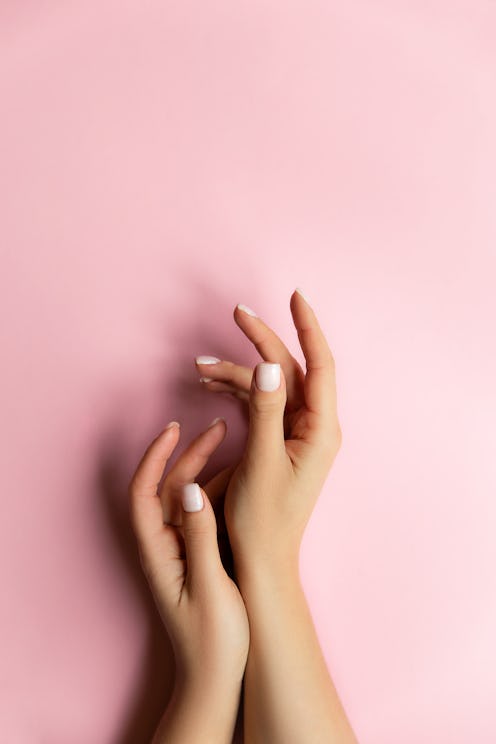Beauty
The Best Way To Remove Your Cuticles, According To Nail Experts
Read this before picking up those clippers.

If you’ve held off on getting your nails done during the pandemic, it’s pretty likely that you’ve been left with overgrown cuticles and dead skin buildup around your nail beds (unless you’re a true DIY mani pro). But getting rid of that isn’t just a matter of snipping the excess skin away — it’s important to know how to remove your cuticles properly for the sake of your nail health.
“The cuticle is the nail’s natural protective seal,” says New York-based dermatologist Dr. Dana Stern, M.D. “It is like the grout in your shower between your tiles — it keeps water, moisture and organisms out of the nail unit.”
When that seal gets irritated by removal, water and moisture can enter the nail unit, causing redness and swelling at the skin behind the cuticle due to yeast, she tells Bustle. So how can you avoid this? Syreeta Aaron, educator at LeChat Nails, says pushing back cuticles is the best tactic; you should never cut off any living tissue, aka eponychium, she says. From start to finish, the removal process actually doesn’t require much equipment. If you have cuticle nippers, a warm towel, and cuticle remover, you should be good to go. Plus, if you moisturize your nail beds with cuticle oil daily, Stern says it’ll keep your nails healthy.
To make your nails look as fresh as possible, here’s a comprehensive guide on how to remove cuticles.
We only include products that have been independently selected by Bustle's editorial team. However, we may receive a portion of sales if you purchase a product through a link in this article.
1Soften And Soak Your Cuticles
For starters, Aaron says to soften your skin by adding a small amount of cuticle remover around your cuticles, then soak them in warm water, a steamed warm towel, or a hand warmer for 3 to 5 minutes. She says whichever method you use will have the same effect, so feel free to wrap your hands in warm towels if you want a full spa experience.
Pro tip: Be extra careful when you use the cuticle remover. “Most cuticle removers contain a high level pH [alkaline] ingredients and should be used carefully,” she says. “It’s important to not allow the cuticle remover to remove living tissue [or eponychium].” This could cause irritation, so only use the solution sparingly.
2Push The Cuticles Back
Instead of clipping them off, Aaron suggests patting the cuticles dry and then pushing them back with a cuticle pusher or orange stick. This can ensure you don’t get rid of or damage any living, healthy tissue.
3Clip Off Dead Skin
If you have excess dead skin building around your cuticles, Aaron recommends removing them with a cuticle nipper. Again, be wary not to get rid of any living tissue in the process.
Darlene Sritapan, OPI North America’s education and capability manager, says cutting in small pieces can cause micro-tears that lead to hangnails. “Start from one side wall and nip to the other sidewall,” she says.
4Wash Your Hands Thoroughly
The last step is super simple and something you’ve probably been excessively practicing since the pandemic started: Wash your hands thoroughly. Aaron says this can ensure all of the cuticle remover gets off your skin.
5Moisturize Often
Stern says the best way to keep up with your nails is by applying oils and ointments daily — both absorb better than creams. “A hydrated cuticle is a healthy cuticle and a healthy cuticle is essential for a beautiful, healthy nail,” she says. “Cuticle oil should be applied throughout the week just like you apply moisturizer to your face every day.” Sritapan says that hydrating your cuticles often can also prevent pesky hangnails.
Moisturizing can also reduce the amount of time you spend removing your cuticles. Aaron says how often you should remove them really “depends upon how fast dead skin accumulates on you as an individual.” But, stay extra attentive during the winter months when your hands tend to be drier, she says.
Studies referenced:
de Berker, D. 2013. Nail anatomy. Clin Dermatol. doi: 10.1016/j.clindermatol.2013.06.006. PMID: 24079579.
Experts:
Dr. Dana Stern, M.D., New York-based dermatologist
Syreeta Aaron, educator at LeChat Nails
Darlene Sritapan, OPI North America’s Education & Capability Manager
This article was originally published on